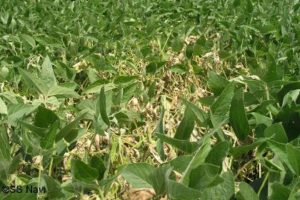The El Nino year of 2015 has created challenging conditions for agronomic management to the Midwest. El Nino years bring cool and wet conditions to the Midwest, which mean trouble for soybean growers. White mold is a fungus that thrives in these types of conditions and infects the plant in the reproductive stages. Entry sites of infection can be at each flower on the plant making the fungus difficult to control.
White mold infections
While wet and cool conditions are favorable for white mold, it doesn’t ultimately determine white mold infection. White mold is caused by Sclerotinia sclerotiorum, a fungus that can persist in the soil for several years.
Growing season conditions like we currently are experiencing, sclerotia sprout light brown fruiting bodies of the fungus, called apothecia and emerge from the soil. The apothecia produce spores which can enter the soybean plant at any abrasion point or senescing flowers. When it infects a flower, the fungus grows down through the flower stalk (pedicel) and invades the stem. Floral infection explains why stem lesions are commonly centered at a node. They also appear to infect at points where dead flower parts adhere to the plant and provide a nutrient source for infection. Once in the plant, the fungus consumes plant nutrients and eventually girdles the stem, killing the tissue above the lesion. For more details, learn more from the Purdue Extension here.

Better under canopy coverage
White mold can infect and take a field with high soybean yield potential and devastate it. This disease can become very aggressive and the biggest key to suppressing white mold is correct timing and proper application. Research has shown that fungicide is best used when applied within the canopy. Historically, we have not had an application option to get adequate coverage within the canopy until now. 360 UNDERCOVER® can provide you that ability. Combining the right product with the most efficient application method gives you more control to help maximize soybean yields.